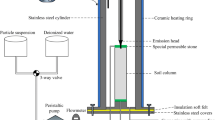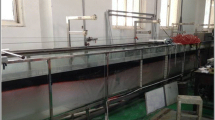Abstract
The build-up of pore-water pressure by waves can lead to sediment liquefaction and subsequent transport by traction currents. This process was investigated by measuring pore-water pressures both in a field experiment and laboratory wave tank tests. Liquefaction was observed in the wave tank tests. The results suggest that sand is less susceptible than silts to wave-induced liquefaction because of the tendency to partially dissipate pore-water pressures. However, previous studies have determined that pore-water pressures must approach liquefaction before current velocities necessary to initiate transport are reduced. Once liquefaction has occurred more sediment can be transported.
Similar content being viewed by others
References
Taylor BD, Vanoni VA (1972) Temperature effects in low transport, flat bed flows. Journal of the Hydraulics Division, American Society of Civil Engineers 97:1427–1445
Miller MC, McCave IN, Komar PD (1977) Threshold of sediment motion under unidirectional currents. Sedimentology 24:507–527
Komar PD, Miller MC (1973) The threshold velocity of sediment under oscillatory water waves. Journal of Sedimentary Petrology 43:1101–1110
Pattiaratchi CB, Collins MB (1984) Sediment transport under waves and tidal currents: a case study from northern Bristol Channel, U.K. Marine Geology 56:27–40
Carstens T, Brebner A, Kamphus JW (1976) Seabed mobility under vertical pressure gradients. Behavior of Off-Shore Structures 1:423–438
Hampton MA, Bouma AH, Carlson PR, Molnia BF, Clukey EC, Sangrey DA (1978) A quantitative study of slope instability in Gulf of Alaska. Proceedings Tenth Offshore Technology Conferenece 4:2307–2318
Wright, SG, Dunham RS (1972) Bottom stability under wave induced loading. Proceedings Fourth Offshore Technology Conference 1:853–862
Seed HB, Rahman MS (1977) Analysis of wave-induced liquefaction in relation to ocean floor stability. Report No. UCB ITE-77/02-University of California, Berkeley, 87 p
McDougall WG, Sollitt CK, Vinson TS, Bell JR (1981) Ocean wave geotextile interaction. SEA Grant Report on Grant No. NA79AA-D-00106-Oregon State University, Corvallis, 143 p
Cross, RH, Huntsman SR, Treadwell DD, Baker VA (1979) Attenuation of pore water pressure in sand. In: Proceedings, Specialty Conference on Civil Engineering in the Oceans IV, American Society of Civil Engineers 2:745–757
Liu PLF (1973) Damping of water waves over porous bed. Journal of the Hydraulics Division, American Society of Civil Engineers 99:2263–2271
Yamamoto T (1978) Sea-bed instability from waves. Proceedings 10th Offshore Technology Conference 1:1819–1828
Okusa S, Uchida A (1980) Pore water pressure changes in submarine sediments due to waves. Marine Geotechnology 4:145–161
Clukey EC, Kulhawy FH, Liu PLF (1984) Response of silts to wave loads: experimental study. In: Symposium on Laboratory and In Situ Determination of the Shear Strength of Marine Soils (STP 833) American Society for Testing and Materials, San Diego
Reineck HE, Singh IB (1980) Depositional and sedimentary environments, Springer-Verlag, New York, 549 p
Reimnitz E, Marshall NF (1965) The effects of the Alaskan earthquake and tsunami on recent deltaic sediments. Journal of Geophysical Research 70:2363–2376
Egan JA, Sangrey DA (1978) Critical state model for cyclic load pore pressure. In: Proceedings American Society of Civil Engineers Specialty Conference on Earthquake Engineering and Soil Dynamics 1:410–424
Lee KL, Fitton JA (1968) Factors affecting the cyclic loading strength of soils. In: Vibration Effects of Earthquakes on Soils and Foundations (STP 450) American Society for Testing and Materials. Philadelphia:71–95
Dalrymple RW (1979) Wave induced liquefaction: a modern example from the Bay of Fundv. Sedimentology 26:835–844
Author information
Authors and Affiliations
Rights and permissions
About this article
Cite this article
Clukey, E.C., Kulhawy, F.H., Liu, P.L.F. et al. The impact of wave loads and pore-water pressure generation on initiation of sediment transport. Geo-Marine Letters 5, 177–183 (1985). https://doi.org/10.1007/BF02281636
Received:
Revised:
Issue Date:
DOI: https://doi.org/10.1007/BF02281636




